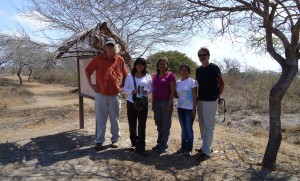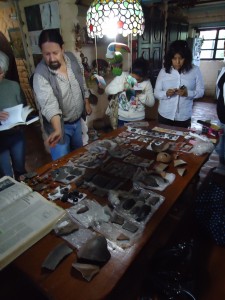Professor of anthropology Jerry Moore and Dr. Francisco Valdez of the Institut de Recherche Pour le Développpement (IRD) laid the groundwork for a bi-national collaboration between archaeologists in Ecuador and Peru this summer for long-term projects to explore the prehistory of the border regions between the two nations.

The two-and-a-half week conference of international university students, archaeologists, and other scholars visited 15 ancient sites in Ecuador and Peru, viewed collections in national museums in both countries, and made public presentations to communities in La Libertad and Cuenca, Ecuador and in Tumbes and Piura, Peru. The project is funded by the Wenner Gren Foundation for Anthropological Research, and the IRD.
“The Wenner Gren Foundation is quite excited about it because this is the first time anyone has had this idea of having a mobile workshop,” says Moore. “Many of these events were held in places where people don’t get the opportunity to hear an international team of archaeologists talking about [excavations and findings] located in their own hometowns.”
Another aspect of the project according to Moore is the fact that there has previously been very little or no collaboration between archaeologists from Peru and Ecuador, despite the fact that there are many parallels between early village life of 3,500 B.C. – 1,000 B.C., which is known as the Formative Period of southern Ecuador and northern Peru. Moore says that the recent discoveries of these areas, some of which were unknown until only five years ago, are helping to mend the somewhat contentious relationship between the scholars of both nations due to a history of border conflicts between Peru and Ecuador for most of the 20th century. He says that the ensuing warfare and nationalist agendas inhibited scholarly exchanges.
“The common interests between archaeologists became more vital than the division between Peruvians and Ecuadorians, which was my hope from the beginning,” he says. “At the moment when [an Ecuadorian] picked up a pot shard and a Peruvian would say, ‘I found something that looks exactly like that,’ that object would become the seed that would open up conversations in a way that would never happen at a regular conference.”
Moore says that the significance of the area’s archaeology, the study of which has only begun in the last 40 to 50 years, lies in the story of ancient indigenous societies and their transition from hunting and gathering to an early agricultural subsistence, along with the beginnings of village governance and social strata. He underscores the fact that although each region approached these changes in distinctively different manners, the overall focus was the same.
“For reasons we don’t really understand at all, these parallel developments are occurring in ancient societies, but along very different tracks,” says Moore. “And yet we have enough evidence to be pretty certain that these societies are in indirect contact with each other… but they’re doing radically different things. What has emerged is a picture that is characterized by a mosaic of diversity, but with contacts. Why that seems to be the case, we don’t know yet. But that’s going to be clearly one of the major research questions for the next decade.”

Moore says that before the conference ended, plans were made to establish common goals for the future of the consortium. Valdez, who is based in Quito, Ecuador, is continuing the work on bi-national research projects to be presented early next year to the ministers of culture in Ecuador and Peru. Other long-term plans include a booklet describing the history of the excavated regions, and enlisting the expertise of international faculty to develop professional training and advanced degrees for students in both countries, particularly Ecuador.
“There are only six Ecuadorean archaeologists with a doctorate,” says Moore. “Only about 20 of them have a master’s degree. Yet Ecuador has this incredible archaeological heritage. There’s a real need to have well-trained people working in these areas. Not only is there the scientific investigation [of sites] but also, Ecuador has environmental laws that require major projects to employ archaeologists who can mitigate the adverse impact [on the environment].”
Moore says that despite some initial hesitation on the part of archaeologists from both nations, once the opportunity to interface occurred, “everyone was very positive.”
“I think that’s the way you can solve these kinds of issues,” says Moore. “You bring people together and focus not on what keeps them apart, but on their common interests. You put them in an environment that is not an artificial one… and in enough different settings so that the bridges they build between each other are not fragile ones. That really worked and it was really exciting.”
Moore is completing a new book, titled “The Prehistory of Home,” which is under contract to the University of California Press. He has also been approached by the University of Colorado Press to write a textbook on the prehistory of South America.
For more information on the anthropology department at CSU Dominguez Hills, click here.